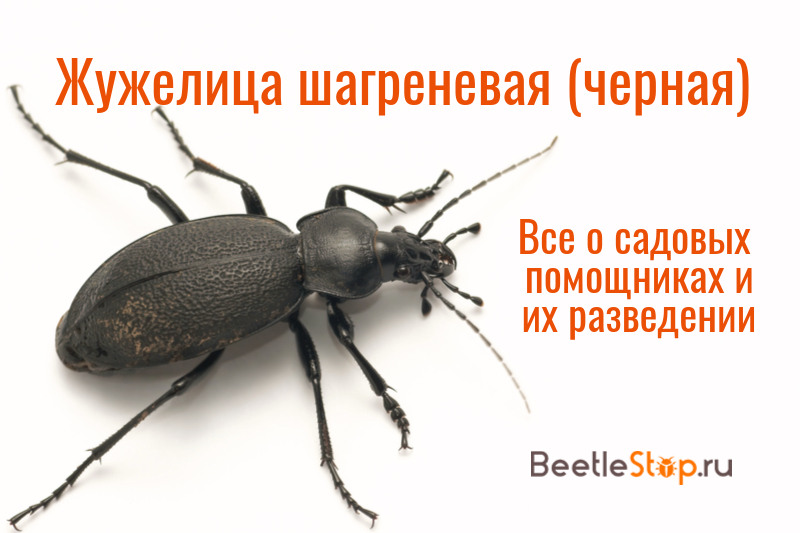Ground beetle shagreen - forest predator is in danger
Ground beetles are a large family of beetles, in which, according to various estimates, from 25 to 50 thousand species. About 3 thousand species live in Russia. Most beetles are predators, they inhibit the spread of phytophage insects, not allowing them to reach a critical level. One of the largest representatives of the family is shagreen beetle. Insects are found in Europe and Russia, in many areas are listed in the Red Book.

Morphological description of the species
Ground beetle shagreen or black (Carabuscoriaceus) belongs to the family and genus ground beetles. The size of adults is 30-42 mm; beetles are the largest representatives of their family in Central Europe. Coloring is black, plain, without metallic sheen. The head is directed forward, weakly drawn into the prothorax. Crescent-shaped mandibles of predatory beetles are adapted to hold prey. The eyes are large, there are no eyes. The upper lip is three-lobed. Longitudinal frontal grooves reach clypeus.
Antennae, which are the organ of touch, consist of 11 segments. Antennas are long, threadlike. The dorsum of the pronotum has rounded protrusions on the sides, its edges are edged, and the surface is in fine punctures. Elytra oval, evenly rounded behind. Cover in rough wrinkles and spots. The elytra completely cover the abdomen, consisting of 6 sternites. The hind wings are reduced.
Information. Sexual dimorphism of ground beetles manifests itself in the structure of the limbs - in males the segments on the forelegs are enlarged. Females are larger than partners, and males have longer antennae.
The extremities of the beetles are black, thin and long. The legs are well adapted for running. On the front tibia there is a device for cleaning the antennae. The legs are 5-segmented.
Lifestyle
The species Carabuscoriaceus is distributed throughout Europe. In Russia, the eastern border of its settlement is the Smolensk region. Beetles live in forests of various types (broad-leaved and mixed), found in old parks. In the ecosystem, shagreen beetle regulates the number of gastropods and other invertebrates. Beetles do not have food specialization. Adults are active at dusk and at night. During the day, insects prefer to hide under fallen trees or stones.
Information. Extragastric digestion is characteristic of predatory ground beetles, they introduce enzymes into the victim’s body, and then suck out the nutrient fluid.
Reproduction begins in the second half of summer. The female lays several tens of oval white eggs on the moss. Campodeevid larvae - they have an elongated body with strong black integument. The head is isolated, the upper lip is reduced. There are three pairs of well developed pectoral legs. The abdomen consists of 10 segments, on the last there are appendages - cerci. Larvae are motile, feed on small insects, terrestrial mollusks. In the process of development, they molt twice and pass three ages. Larvae burrow in the litter or soil during the day. They hunt on the ground.
Overwintering larvae, ending their development next spring, and part of the imago. Pupation occurs in the spring in an underground cradle. Pupa free, naked, similar to a bug. The preimaginal stages of the species Carabuscoriaceus are poorly understood.
Predatory ground beetles themselves often suffer from natural enemies. Tick bugs parasitize on adult bugs, birds, mammals, reptiles prey on them. Riders, tahini flies, and nematodes feed on larvae.
Security status
The number of ground beetle shagreen is reduced in all habitats. Several factors contribute to the reduction of the species:
- Deforestation, which is a natural biotype of beetles.
- Recreational loads in the habitat.
- Lack of wings and weak migratory ability of beetles.
- Chemical treatment of forests.
Ground beetle shagreen is listed in the Red Book of the Chuvash Republic, Belarus, Lithuania, Smolensk region of the Russian Federation. To preserve the species, it is necessary to prohibit the collection of insects, the reconstruction of parks and forests in the habitats of beetles, and reduce recreational use.
Captive breeding
To control agricultural pests, carnivorous beetles are planted in cages. Several pairs of ground beetles are placed in aquariums with soil and a layer of moss. Females lay eggs. Young larvae are caught and placed separately to avoid cannibalism. Adults and larvae are fed with earthworms, slugs, snails. Beetles need water to quench their thirst for rinsing the mouth. For the winter, a container with larvae is placed in the refrigerator or basement. In spring, the insect pupates. After 6-12 days, imagoes crawl out of the soil, which can be released into the area attacked by pests. Ground beetles are difficult to breed in captivity, their industrial use is limited.


